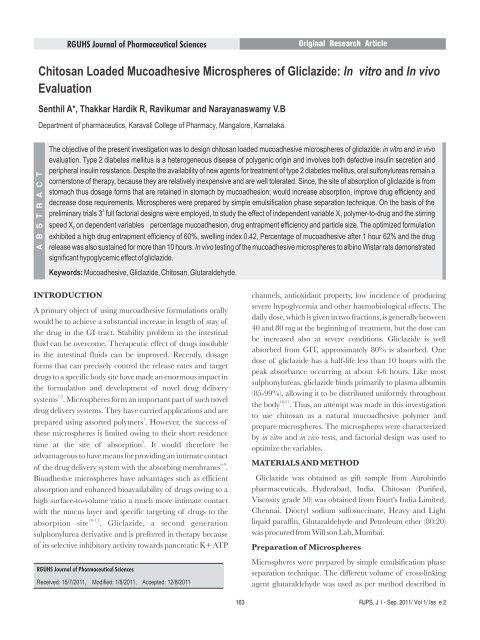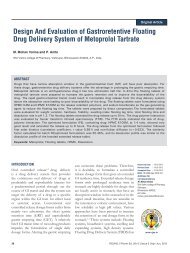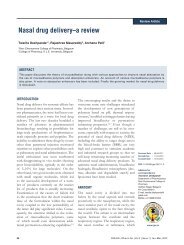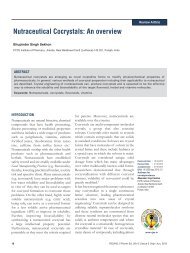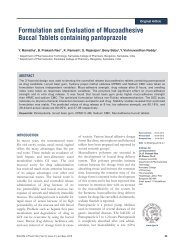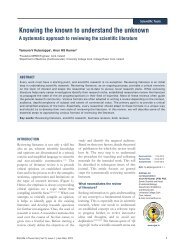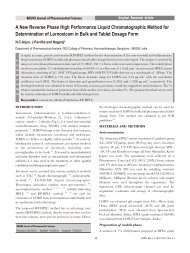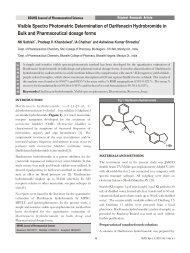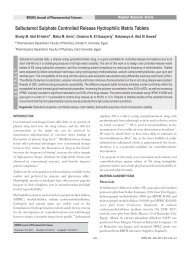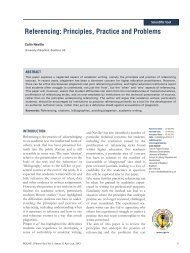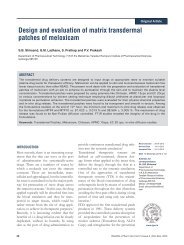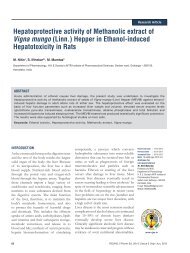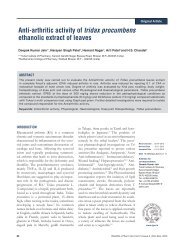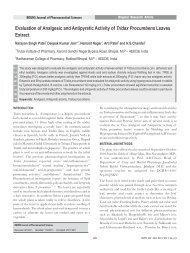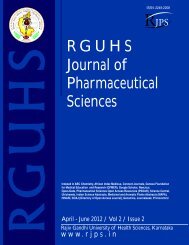Chitosan Loaded Mucoadhesive Microspheres of Gliclazide - Journal
Chitosan Loaded Mucoadhesive Microspheres of Gliclazide - Journal
Chitosan Loaded Mucoadhesive Microspheres of Gliclazide - Journal
Create successful ePaper yourself
Turn your PDF publications into a flip-book with our unique Google optimized e-Paper software.
A B S T R A C T<br />
RGUHS <strong>Journal</strong> <strong>of</strong> Pharmaceutical Sciences<br />
<strong>Chitosan</strong> <strong>Loaded</strong> <strong>Mucoadhesive</strong> <strong>Microspheres</strong> <strong>of</strong> <strong>Gliclazide</strong>: In vitro and In vivo<br />
Evaluation<br />
Senthil A*, Thakkar Hardik R, Ravikumar and Narayanaswamy V.B<br />
Department <strong>of</strong> pharmaceutics, Karavali College <strong>of</strong> Pharmacy, Mangalore, Karnataka.<br />
The objective <strong>of</strong> the present investigation was to design chitosan loaded mucoadhesive microspheres <strong>of</strong> gliclazide: in vitro and in vivo<br />
evaluation. Type 2 diabetes mellitus is a heterogeneous disease <strong>of</strong> polygenic origin and involves both defective insulin secretion and<br />
peripheral insulin resistance. Despite the availability <strong>of</strong> new agents for treatment <strong>of</strong> type 2 diabetes mellitus, oral sulfonylureas remain a<br />
cornerstone <strong>of</strong> therapy, because they are relatively inexpensive and are well tolerated. Since, the site <strong>of</strong> absorption <strong>of</strong> gliclazide is from<br />
stomach thus dosage forms that are retained in stomach by mucoadhesion; would increase absorption, improve drug efficiency and<br />
decrease dose requirements. <strong>Microspheres</strong> were prepared by simple emulsification phase separation technique. On the basis <strong>of</strong> the<br />
2<br />
preliminary trials 3 full factorial designs were employed, to study the effect <strong>of</strong> independent variable X polymer-to-drug and the stirring<br />
1<br />
speed X on dependent variables percentage mucoadhesion, drug entrapment efficiency and particle size. The optimized formulation<br />
2<br />
exhibited a high drug entrapment efficiency <strong>of</strong> 60%, swelling index 0.42, Percentage <strong>of</strong> mucoadhesive after 1 hour 62% and the drug<br />
release was also sustained for more than 10 hours. In vivo testing <strong>of</strong> the mucoadhesive microspheres to albino Wistar rats demonstrated<br />
significant hypoglycemic effect <strong>of</strong> gliclazide.<br />
Keywords: <strong>Mucoadhesive</strong>, <strong>Gliclazide</strong>, <strong>Chitosan</strong>, Glutaraldehyde.<br />
INTRODUCTION<br />
A primary object <strong>of</strong> using mucoadhesive formulations orally<br />
would be to achieve a substantial increase in length <strong>of</strong> stay <strong>of</strong><br />
the drug in the GI tract. Stability problem in the intestinal<br />
fluid can be overcome. Therapeutic effect <strong>of</strong> drugs insoluble<br />
in the intestinal fluids can be improved. Recently, dosage<br />
forms that can precisely control the release rates and target<br />
drugs to a specific body site have made an enormous impact in<br />
the formulation and development <strong>of</strong> novel drug delivery<br />
1-3<br />
systems . <strong>Microspheres</strong> form an important part <strong>of</strong> such novel<br />
drug delivery systems. They have carried applications and are<br />
1<br />
prepared using assorted polymers . However, the success <strong>of</strong><br />
these microspheres is limited owing to their short residence<br />
5<br />
time at the site <strong>of</strong> absorption . It would therefore be<br />
advantageous to have means for providing an intimate contact<br />
6-9<br />
<strong>of</strong> the drug delivery system with the absorbing membranes .<br />
Bioadhesive microspheres have advantages such as efficient<br />
absorption and enhanced bioavailability <strong>of</strong> drugs owing to a<br />
high surface-to-volume ratio a much more intimate contact<br />
with the mucus layer and specific targeting <strong>of</strong> drugs to the<br />
10-13<br />
absorption site . <strong>Gliclazide</strong>, a second generation<br />
sulphonylurea derivative and is preferred in therapy because<br />
<strong>of</strong> its selective inhibitory activity towards pancreatic K+ ATP<br />
RGUHS <strong>Journal</strong> <strong>of</strong> Pharmaceutical Sciences<br />
Received: 15/7/2011, Modified: 1/8/2011, Accepted: 12/8/2011<br />
163<br />
Original Research Article<br />
channels, antioxidant property, low incidence <strong>of</strong> producing<br />
severe hypoglycemia and other haemobiological effects. The<br />
daily dose, which is given in two fractions, is generally between<br />
40 and 80 mg at the beginning <strong>of</strong> treatment, but the dose can<br />
be increased also at severe conditions. <strong>Gliclazide</strong> is well<br />
absorbed from GIT, approximately 80% is absorbed. One<br />
dose <strong>of</strong> gliclazide has a half-life less than 10 hours with the<br />
peak absorbance occurring at about 4-6 hours. Like most<br />
sulphonylureas, gliclazide binds primarily to plasma albumin<br />
(85-99%), allowing it to be distributed uniformly throughout<br />
18-21<br />
the body . Thus, an attempt was made in this investigation<br />
to use chitosan as a natural mucoadhesive polymer and<br />
prepare microspheres. The microspheres were characterized<br />
by in vitro and in vivo tests, and factorial design was used to<br />
optimize the variables.<br />
MATERIALS AND METHOD<br />
<strong>Gliclazide</strong> was obtained as gift sample from Aurobindo<br />
pharmaceuticals, Hyderabad, India. <strong>Chitosan</strong> (Purified,<br />
Viscosity grade 50) was obtained from Fourt's India Limited,<br />
Chennai. Dioctyl sodium sulfosuccinate, Heavy and Light<br />
liquid paraffin, Glutaraldehyde and Petroleum ether (80:20)<br />
was procured from Will son Lab, Mumbai.<br />
Preparation <strong>of</strong> <strong>Microspheres</strong><br />
<strong>Microspheres</strong> were prepared by simple emulsification phase<br />
separation technique. The different volume <strong>of</strong> cross-linking<br />
agent glutaraldehyde was used as per method described in<br />
RJPS, Jul - Sep, 2011/ Vol 1/ Issue 2


